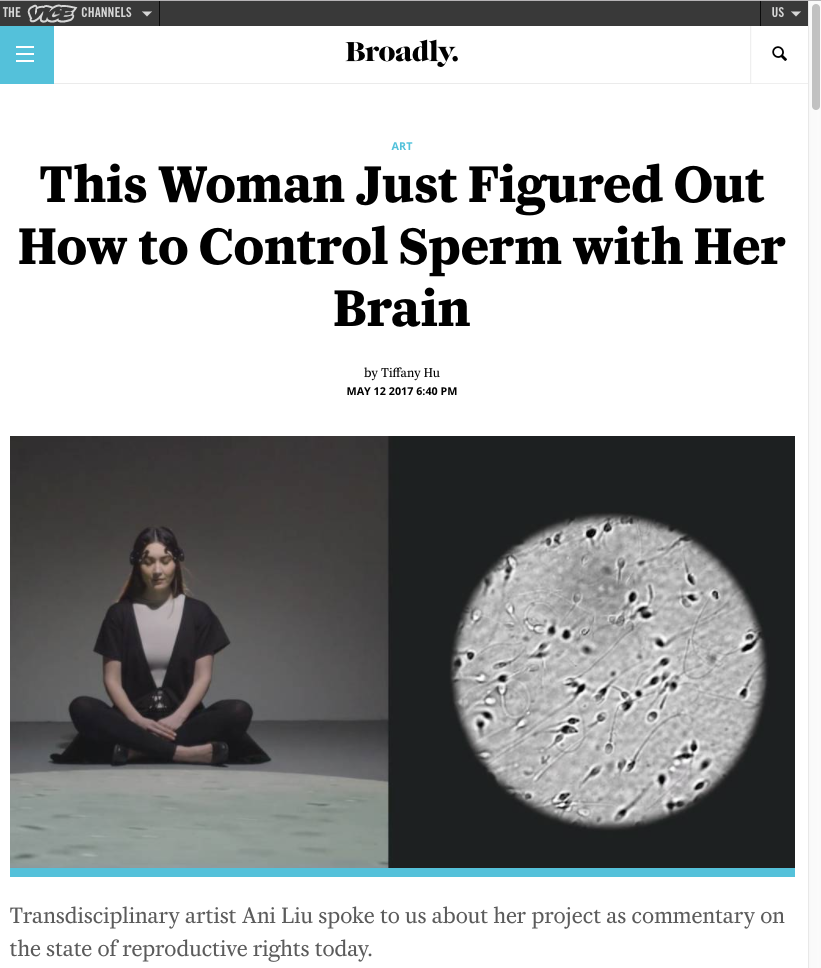Mind Controlled Spermatozoa
This is a system designed to allow women to control the directional movement of sperm with the agency of their thoughts. It was developed as a response to Donald Trump’s statement “Grab them by the pussy” in the 2016 election.
The female body has long been a site of contention, where opposing ideologies in religion, politics, and cultural differences often play out. The female body has become a vessel by which systems of ideas are manifested. Can a woman vote or serve in the military? Can she wear pants, or must she be veiled? Does she have agency in deciding her own reproductive health choices?
Reflecting on the cultural and scientific discourses that shape notions of the female body, this project challenges the status quo. In an expression of female empowerment, a woman controls something symbolically male: spermatozoa (sperm). Through the use of a brain-computer interface, she controls the movement of sperm with the agency of her thoughts.
This project uses a brain EEG device to translate thoughts onto a custom circuit on a glass slide, where the movement of sperm is controlled through electric fields in a phenomena known as galvanotaxis.
As a work of art, the goal is to create an act of female empowerment, responding to patriarchal regimes in which female reproductive rights are being challenged. Investigating the body as a medium of culture, this project raises questions on how we operate in our politically gendered landscape. Through the use of science and technology as a medium, this work presents a hope to expand our notions of what is possible in the cultural landscape of scientific reality.
Introduction
The female body has long been a site of contention, where opposing ideologies in religion, politics, and cultural differences often play out. A body is not just a body; it has become a vessel by which systems of ideas are manifested. Can a woman vote or serve in the military? Does she have agency in deciding her own reproductive health choices? Can she wear pants, or must she be veiled? The first two examples-- voting and serving in the military-- reflect the way we construct our political reality through the civic administration of bodies. The second example, that of reproductive health, reflects the complex interplays between our scientific and cultural beliefs surrounding biology and what we consider “natural.” The last two examples-- the type of garment she is or is not allowed to adorn her body with-- serve as reinforcing cultural signifiers for our beliefs.
It is well into the twenty-first century, and although I live in a well developed Western democracy, gender inequalities still persist. These inequalities are pervasive in a myriad of ways: reflected in the disparity of gender diversity in political representation and participation, in the gender pay gap, in prejudice, and in violence and sexual assault. Closely related to these issues of gender inequality is that of women’s health, and who has control over these choices. In 2017, US President Donald Trump signed an executive order which cut off all U.S. funding to international NGOs whose work includes abortion services or advocacy. Images of this executive order being signed by Donald Trump flanked by a cabinet of men have widely circulated, with the subtitle, “As long as you live you’ll never see a photograph of 7 women signing a legislation about what men can do with their reproductive organs.” This image, along with the caption, brings to light the gender imbalances in the authorities making policies concerning women.
Devastatingly, beyond his political actions, U.S. President Trump has also been recorded making incredibly misogynist statements, including: “You can do anything ... Grab them by the pussy. You can do anything.” Statements such as these, combined with executive orders that specifically impact particular genders create a biased illusion of normality. Recent events such as these, along with a long history of gender inequality, have caused me to investigate the interwoven forces that shape our perceptions of gender, and to consider how we might shift them.
Reflecting on the cultural and scientific discourses that shape notions of the female body, I seek to challenge this status quo by engineering a system by which I (a woman) can control something inherently and symbolical male: spermatozoa (sperm). Through the use of a brain-computer interface, I control the movement of sperm along an XY axis with the agency of my thoughts.
While at first glance the idea of controlling sperm might be absurd, it is my hope that it causes the viewer to reflect on the very real absurdities of control happening to the bodies of women. Genital mutilation, forced sterilization, sexual abuse, rape, and contraceptive regulation currently occur as forms of control projected onto female bodies. In creating a subversive counter-narrative to these practices of control, this thesis presents a hope for reimagining and shifting our notions of gender.
Objectives
As a work of art, this work creates an act of female empowerment, responding to patriarchal regimes in which female reproductive rights are being challenged. Investigating the body as a medium of culture, this project raises questions on how we operate in our politically gendered landscape. Through the use of science and technology as a medium, this thesis presents a hope to expand our notions of what it is possible in the cultural landscape of reality.
Motivation
The subjectivities of humans have long been influenced by scientific and technological breakthroughs. Some scientific revolutions, such as Copernicus’ model, which shifted the center of the universe from the Earth to the Sun had religious implications. Other breakthroughs, such as that of synthetic biology, raise philosophical and existential questions on what life is. With every technology and scientific development, our plastic subjectivity goes through modifications and expansions.
As Sophia Roosth and Astrid Schrader eloquently ask in their article “Feminist Theory Out of Science: Introduction”:
“What is the relationship of critical feminist theory to science studies? How might we envision critical theory’s encounter with scientific accounts of the world? Might we read scientific theories as already critical, the lived world as already doing science, busily generating theories of itself?.... How do scientific theories inform cultural critique? How might scholars generate critical theories out of scientific ones?”
With every technology and scientific breakthrough, our plastic subjectivity goes through modifications and expansions. As an artist, I reflect on and expose these forces in works incorporating the language and techniques of science and technology. In the creation of this work, two systems of thought related to gender are investigated: that of biology, and that of body politics. Bridging between these systems is culture- our notions of gender do not solely exist anatomically- they are constructed culturally, subjectively, and socially. These social constructs are effected by our scientific objectivity and political veracity. It is my aim to harness what I’ve learned to subvert the status quo of what we know about the egg and sperm to draw to reveal the absurdities of current control practices regarding gender and reproductive health.
What are some counter narratives to this male dominated history of female discrimination? In an age of technological advancement where we often speak of transcending our bodies to the point of posthumanism, why are we still influenced by dubious theories of biological determinism? In this project, I explore these themes through the symbolic act of controlling the cellular unit of male reproduction.
Engineering the System
I am creating a system by which a woman can control the movement of sperm with her mind. This system utilizes several different technologies, which are described in further detail below. A Brain Computer Interface (BCI) is used to read the electrical signals from my brain, and these signals are translated into commands for a microcontroller. Through these commands, the microcontroller moderates the charges on a circuit on which semen is placed. The directional motility of sperm is gained through a phenomena known as galvanotaxis, where cells migrate towards a specific charge in an electric field. A microscope connected to a digital camera sends live images to a video screen to allow viewers to see the directional movement of the sperm. Through this system, the motility of sperm on an XY coordinate system is gained through the thoughts of a woman.
Galvanotaxis and Electrophoresis in Sperm
Galvanotaxis, also known as electrotaxis, refers to a phenomena where cells migrate directionally towards electrodes in a direct current (DC) electric field (EF). Galvanotaxis has been observed and documented in over 14 cell types, including mammalian granulocytes, bone cells, amphibian neural crest cells, and mouse sperm.
Electrophoresis refers to the motion of dispersed particles in a fluid under an electric field. Standard, mature human sperm carry a net negative charge, and electrophoresis can be used to move sperm towards the positive electrode under an electric field. This technique has been used to separate out larger, more robust sperm for processes related to in vitro fertilization (IVF).
Using a combination of the phenomena of galvanotaxis and electrophoresis, I am directing the movement of sperm through the manipulation of electric fields. As mentioned above, the specifications I have come to through experimentation is 12V/cm.
Diagram to show electrophoretic effect on sperm. Sperm will move towards the negatively charged cathode at 12V/ cm.
Brain Computer Interface (BCI / EEG)
An electroencephalogram (EEG) is a method of electrophysiological monitoring- recording the electrical activity of the brain. A brain-computer interface (BCI) takes this EEG electrical activity, analyzes them, and sends the signals to a computer which can be programmed for various commands and outputs.
Within the last 15 years, commercially available BCIs have unlocked a proliferation of its usage for creative means of expression. Reflecting on an era of continual human computer symbiosis, I am incorporating BCI technology into my project to further investigate the threshold and continuum between the mind and the body as augmented by a computer interface.
Optics / Microscope
The system for optics in this project is a USB enabled digital camera connected to a microscope. The video footage gathered from the microscope will be collected onto a computer and live streamed through a projector, to allow for an immersive experience of the performance. Human spermatozoa are typically 50 micrometers in length, and require a microscope objective of at least 10X. In my tests, a magnification of at least 40x is desired, for clarity and proper resolution for projection.
Image of the current setup in my lab. A consumer grade toy microscope with a USB camera is streaming live footage of the contents on the slide onto the screen of my laptop. Electrodes placed 5/12 cm apart is controlled by an Arduino UNO sending 5V, achieving the effect of sperm migration towards the cathode. Final set up of tis project will include a large projection of the sperm movement.
References
Allen, Greg M., Alex Mogilner, and Julie A. Theriot. "Electrophoresis of Cellular Membrane Components Creates the Directional Cue Guiding Keratocyte Galvanotaxis." Current Biology 23, no. 7 (2013): 560-68. doi:10.1016/j.cub.2013.02.047.
Bullock, Penn. "Transcript: Donald Trump’s Taped Comments About Women." New York Times. October 8, 2016. https://www.nytimes.com/2016/10/08/us/donald-trump-tape-transcript.html?_r=0.
Buzsáki, G. 2006. Rhythms of the brain. n.p.: Oxford ; New York : Oxford University Press, 2006.,
Cira NJ, Chung AM, Denisin AK, Rensi S, Sanchez GN, Quake SR, et al. (2015) A Biotic Game Design Project for Integrated Life Science and Engineering Education. PLoS Biol 13(3): e1002110. doi:10.1371/journal.pbio.1002110
Fleming, Steven, and R. John Aitken. "Electrophoretic Sperm Separation." Sperm Chromatin, 2011, 423-29. doi:10.1007/978-1-4419-6857-9_29.
Foucault, Michel, and Michel Senellart. The birth of biopolitics lectures at the college de France, 1978-1979. New York: Palgrave Macmillan, 2011.
Foucault, Michel, and François Ewald. Society must be defended: lectures at the Collége de France, 1975-76. London: Penguin, 2008.
Gao, R.-C., X.-D. Zhang, Y.-H. Sun, Y. Kamimura, A. Mogilner, P. N. Devreotes, and M. Zhao. "Different Roles of Membrane Potentials in Electrotaxis and Chemotaxis of Dictyostelium Cells." Eukaryotic Cell 10, no. 9 (2011): 1251-256. doi:10.1128/ec.05066-11.
Ihde, Don. Bodies in technology. Minneapolis: University of Minnesota Press, 2010.
Koran, Laura, and James Masters. "Trump reverses abortion policy for aid to NGOs." CNN. January 24, 2017. Accessed February 05, 2017. http://www.cnn.com/2017/01/23/politics/trump-mexico-city-policy/.
Nijholt, Anton, and Chang S. Nam. "Arts and Brain-Computer Interfaces (BCIs)." Brain-Computer Interfaces 2, no. 2-3 (2015): 57-59. doi:10.1080/2326263x.2015.1100514.
Riedel-Kruse, Ingmar H., Alice M. Chung, Burak Dura, Andrea L. Hamilton, and Byung C. Lee "Design, engineering and utility of biotic games." Lab Chip 11, no. 1 (September 23, 2010): 14-22. doi:10.1039/c0lc00399a.
Roosth, S., and A. Schrader. "Feminist Theory Out of Science: Introduction." Differences 23, no. 3 (2012): 1-8. doi:10.1215/10407391-1892880.
Rouge, Melissa. "Sperm Motility." Sperm Motility. January 20, 2003. Accessed February 05, 2017. http://www.vivo.colostate.edu/hbooks/pathphys/reprod/semeneval/motility.html.
Rytis, Maskeliunas, Damasevicius Robertas, Martisius Ignas, and Vasiljevas Mindaugas. 2016. "Consumer-grade EEG devices: are they usable for control tasks?." Peerj, Vol 4, P E1746 (2016) e1746. Directory of Open Access Journals, EBSCOhost (accessed April 16, 2017).
WITW STAFF. "Photo of Trump and male staffers signing anti-abortion measure inspires feminist satire." New York Times. January 27, 2017. Accessed February 5, 2017. http://nytlive.nytimes.com/womenintheworld/2017/01/27/photo-of-trump-and-male-staffers-signing-anti-abortion-measure-inspires-feminist-satire/.
Press:
VICE: This Woman Just Figured Out How to Control Sperm with Her Brain
Fox News: This Artist Used Tech to Control Sperm with her Mind
Adafruit Blog: Mind Controlled Spermatozoa
Art F City: In “Mind-Controlled Sperm: Woman of STEAM Grabs Back” Ani Liu Flips the Script
Art Tech Blog PijamaSurf: MUJER CONTROLA ESPERMA CON SUS PENSAMIENTOS
Addivism.org: This Woman Figured Out How to Control Sperm with Her Brain
medium
single channel film 00:03:12
sperm, glass slide, custom made circuit, microscope, projector, microcontroller
year
2016-2017
exhibitions
Mana Contemporary
Boston Center for the Arts
MU Hybrid Arthouse
tags
biopolitics, reproduction, gender, technoscience, feminism

















